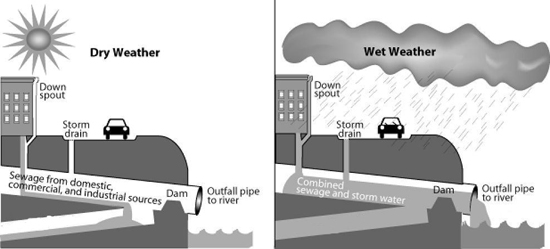
Helping Cities Benefit from Green Infrastructure
EPA provides research and guidance on the incorporation of green infrastructure into Omaha's combined sewer overflow control plan
In collaboration with the City of Omaha and the Nebraska Department of Environmental Quality (NDEQ), EPA scientists are analyzing soils and preparing monitoring equipment to reduce the incidence of combined sewer overflows (CSOs) using green infrastructure.

Combined sewer systems can lead to overflows during heavy rain.
As the name implies, combined sewer systems route both sewage and stormwater into common networks of pipes and tend to overflow during heavy rainfall. Like hundreds of U.S. communities, Omaha is working to reduce the occurrences of CSOs, which contaminate water resources and threaten human and environmental health.
EPA is providing guidance on how the city and NDEQ can incorporate green infrastructure--features such rain gardens, rain barrels, cisterns and natural areas that absorb or reduce runoff--into their CSO control plan. Both the city and state asked EPA scientists to assist them with at least 14 sites under consideration for green infrastructure installations.

EPA's Bill Shuster and soil scientist Steve Dadio examine a soil core.
The Minnelusa watershed in Omaha offers a likely location for using green infrastructure, such as rain gardens, that would capture stormwater runoff from sidewalks and soak it up before it reaches the combined sewer system. In July, a team of EPA researchers, led by Dr. Bill Shuster, collected soil samples from each potential green installation location. By analyzing sample cores of both topsoil and subsoil, Shuster’s team can determine the ability of those sites to effectively capture stormwater.
“All soils move water, but some are better than others,” explained Shuster. “We need to know how Omaha soils move water before we can plan how to put stormwater into those soils.”
Once the city and state agree on the types and locations of green infrastructure installations, EPA will work with the local USGS to establish monitoring sites around these installations. Monitoring will begin before the green infrastructure is installed and will continue after installation to determine how well it performs with respect to water capture and infiltration.
“The idea is to have data that demonstrates how effective the green infrastructure was at capturing rainfall locally,” explained Dr. Alice Gilliland, an EPA scientist involved with green infrastructure research planning.
Through this collaboration with community and state partners, the impact of this EPA research will extend far beyond Omaha.
“Having this kind of community involvement can help the individual community,” said Gilliland. “But it also helps develop a protocol to show other communities how they could approach the same issue. There are many communities dealing with this CSO problem.”
Learn More
Why Study Green Infrastructure?
